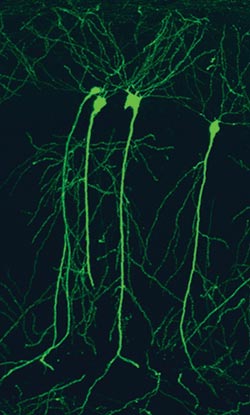| 2006 |

|
YEAR BOOK |
University College Cork
|
Monitoring and manipulating brain cells in mice
|

To better understand how neural circuits work we have developed a new technique to monitor and manipulate neurons in the brains of mice. This new technique is called single-neuron labeling with inducible cre-mediated knockout "SLICK". It was developed by incorporating an artificial transgene into the DNA of mice. The transgene was designed so that it would cause neurons in these mice to produce two proteins. One is a green fluorescent colored protein that labels neurons so that they can be visualized under a microscope. The second protein, cre recombinase, enables genes to be turned on/off in the labeled neurons. This technique allows researchers to visualize the morphology of individual neurons and deduce the patterns of connections that they make within the brain. At the same time it is possible to manipulate the neurons genetically. In this way it is possible to determine how particular genes affect the flow of information within neural circuits.
Genetic factors contrib-ute to most neurological diseases, and often many genes influence suscept-ibility to a particular disease. The human genome project has identified all the genes that comprise our molecular blueprint. The challenge of the "post-genomic era" is to assign and characterize the functions of these genes.
This is especially difficult in the brain because of its complexity. The SLICK method is designed to overcome these challenges and should permit the neural functions of genes to be determined with great precision. One future direction of this research will be to apply this novel technique to study genes that are thought to play a role in neurological diseases such as mental retardation.
Contact: Paul Young, Department of Biochemistry, Biosciences Institute, University College Cork,
E-mail: [email protected]
Website: http://www.ucc.ie/ucc/depts/biochemistry/staff/pyoung.html